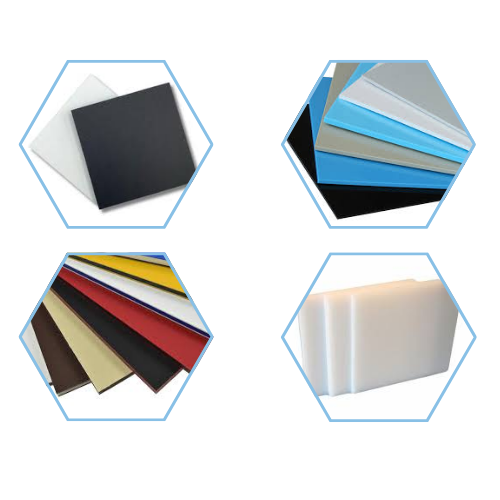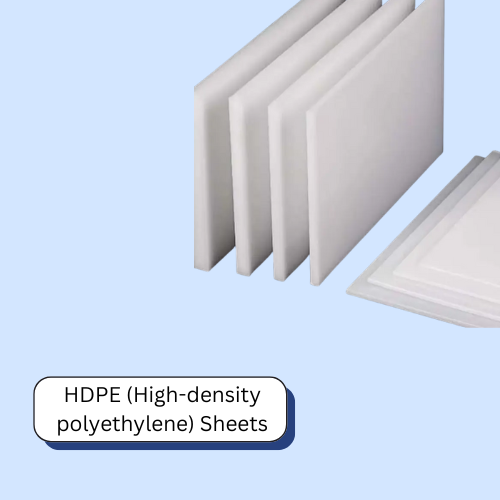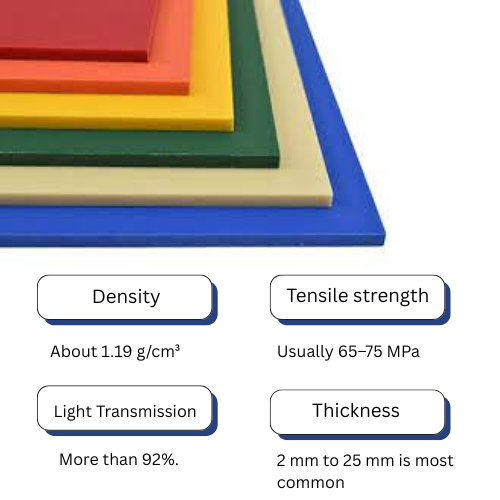What are HDPE (High-density polyethene) Sheets?
Made from a hard type of polyethene, HDPE sheets are strong and lightweight plastic sheets. These sheets don’t get easily damaged by any kind of chemicals, water, or weather, so they are safe and the perfect choice for several uses, like making pipes, containers, and packaging.
Because they are easy to cut and shape, and can be recycled, HDPE sheets are popular in many industries for different kinds of work, which makes them popular in many industries. Their strength, durability, and safety for food contact add to their usefulness in everyday products and industrial applications.
Features
HDPE sheets have several useful features:
- Chemical resistant: these sheets don’t get damaged easily by acids or any other chemicals.
- Strong and tough: They are able to handle strong impacts without breaking or tearing.
- Lightweight: these are easy to carry, cut, and install.
- Weatherproof: Can be used outdoors; not damaged by sun, rain, or heat.
- Waterproofed: such sheets absorb a very small amount of water, so they are a good choice for wet places.
- Good insulator: it doesn’t conduct electricity, which makes it a safe choice for any electrical uses.
- Recyclable: These sheets can be recycled and reused, making them eco-friendly.
- Easy to shape: it can be cut, joined, or moulded into different shapes.
- Wear-resistant: even after using or rubbing regularly, it still stays strong and durable,
- Food safe: Some of these types of sheets are safe for food contact and kitchen use.
Applications
HDPE sheets are used in several places because of their nature. Here are some common applications:
- Water and Gas Pipes: widely used to carry water and gas safely in homes, farms, and industries.
- Plastic Bottles: Made into bottles for milk, shampoo, water, and cleaning products.
- Food Containers: These are used to make safe containers and cutting boards for food.
- Fuel Tanks: Used for storing fuel in vehicles and machines.
- Packaging Bags: Made into grocery bags and bread bags.
- Hard Hats: These are used for safety helmets in construction and factories.
- Telecom Ducts: Protect cables for telephone and internet lines.
How to Use HDPE Sheets and Rods?
Here is a step-by-step process for using HDPE sheets:
- Select the needed size and thickness for your work.
- Cut the sheet to the required shape with the help of a saw or a cutter.
- Smooth any rough borders with sandpaper to avoid injury.
- Drill holes if you need to fix the sheet with screws or bolts.
- Attach the sheet by screwing, bolting, or welding.
- Clear the surface area with a wet cloth to clear dust and dirt.
- Place the sheet in the needed place, for covers, containers, or barriers.
- Keep the HDPE sheet clean and look for any kind of damage.
Safety Guidelines
To work safely with HDPE sheets, you should always follow these important safety tips:
- Always put on gloves to protect your hands from damage while cutting or handling sheets.
- Use goggles to cover your eyes from dust and small plastic pieces.
- Cut sheets on a stable surface using the right tools to avoid accidents.
- Keep your work area clean to control slips and falls.
- Avoid inhaling dust by working in a well-ventilated area or using a mask.
- Store HDPE sheets flat and away from direct sunlight to keep them in good condition.
- Handle sheets carefully to avoid sharp edges that can cause cuts.
- Follow proper waste disposal and recycling methods for scrap pieces.




